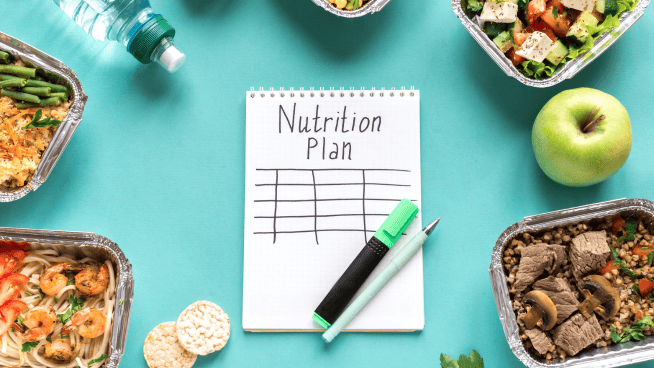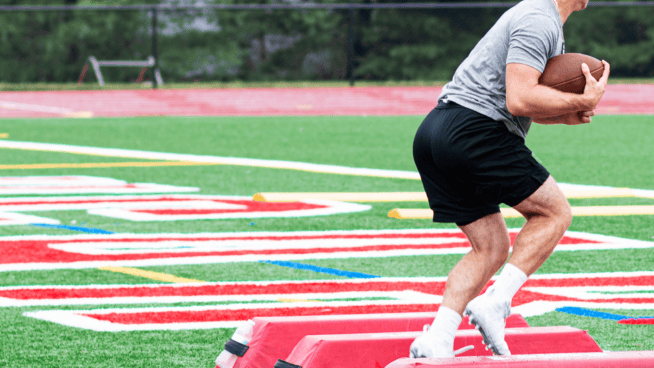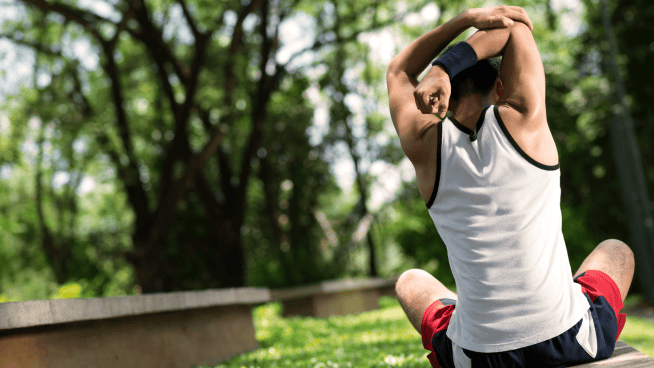The 12 Best RDL Variations
The Romanian Deadlift—also known as the RDL and Straight-Leg Deadlift—is the lesser-known cousin of the Deadlift. Although you may not see it as frequently in training programs, it’s an important exercise for developing your glutes and hamstrings—two critical muscle groups for sports performance.
There are many different variations of this exercise—each serving a specific purpose. We polled seven strength coaches to find out which RDL variations are best for athletes. They came up with an even dozen:
RELATED: 3 Ways You’re Messing Up Your RDL
1. Barbell RDL
The Barbell RDL is the fundamental move on which all the other variations are based. “Simply put, it’s a fantastic exercise to develop the posterior chain, and it serves as a nice accessory movement to regular Deadlifts,” says Tony Gentilcore, co-founder of Cressey Sports Performance (Hudson, Massachusetts). If you want to develop strong and powerful glutes and hamstrings, this move should be in your program.
How to:
- Stand with your feet hip-width apart and hold a barbell at thigh level with a shoulder-width grip.
- Keeping your back straight, bend at your waist and sit your hips back to lower the bar.
- With the bar close to your shins, continue to lower as far as flexibility allows.
- Forcefully contract your glutes to extend your hips and stand up to the starting position.
2. Dumbbell RDL
If you don’t have a barbell, this is next best alternative.
How to: Perform an RDL holding dumbbells instead of a barbell.
3. Single-Arm, Single-Leg RDL
“The Single-Leg RDL allows us to train unilaterally [on one leg] while working on motor control and balance,” says Ramsey Nijem, assistant strength coach for the Sacramento Kings. “It hits the major muscle groups on the backside of the body and works to eliminate strength imbalances between the left and right sides.”
How to:
- Balance on one leg and hold a dumbbell in your opposite hand at your hip.
- With your balancing leg slightly bent and your back flat, bend forward at the waist to lower the dumbbell as far as your flexibility allows.
- Forcefully contract your glute to extend your hip and return to the starting position.
4. Single-Arm, Single-Leg RDL (same side)
Ben Boudro, director of strength and conditioning at Xceleration Sports Performance (Auburn Hills, Michigan), says that switching the dumbbell to the same hand as your working leg forces your core to work harder to maintain stability.
How to: Same as above, but hold the dumbbell with your hand on the same side as your working leg.
5. Single-Leg Barbell RDL
This advanced variation of the Barbell RDL trains one leg at a time. You won’t be able to lift as much weight, but you will improve single-leg strength and stability. Also, stabilizing the barbell challenges your core. Check out the video player above to see Drew Brees demonstrate the Single -Leg RDL with Kettlebells.
How to: Perform a Single-Leg RDL holding a barbell.
6. Dead Start Single-Arm, Single-Leg RDL
The Dead Start variation starts halfway through the rep, adding a new twist to the exercise. Gentilcore says, “This is a great way to groove better technique, as it forces you to experience what the finished position is supposed to feel like.”
Tony Bonvechio, owner of Bonvec strength and an intern at Cressey Sports Performance, says, “This variation keeps the weight from drifting too low or too far out in front of the body. It’s a good introduction to Single-Leg RDLs.”
How to:
- Place a dumbbell on a slightly elevated surface, like a stepper, in front of you.
- Bend over as if performing a Single-Arm, Single-Leg RDL, grasp the dumbbell and perform a full rep, starting from the bottom position.
- Lower the weight back to the stepper and repeat.
WATCH: Andre Ethier’s Max Strength RDL
7. Single-Leg RDL with Forward Reach
“We do almost all of our RDLs on one leg,” says Alan Stein, owner of Stronger Team and strength coach for the DeMatha Catholic boy’s basketball team. “It’s one of the most important movements for athletes.”
Stein works almost exclusively with basketball players, who often have a strength and/or stability discrepancy from leg to leg—as do athletes in other sports. Once his athletes master this movement with their own weight, he has them hold a basketball and extend their arms out as they lower into the rep. You can also hold a med ball or a piece of equipment used in your sport, like a football or hockey stick. “Extending the weight straight out instead of straight down to the floor makes it more challenging,” Stein says.
How to:
- Set up for a Single-Leg RDL.
- Keeping your core tight, extend your arms overhead as you lower into the rep.
8. Snatch-Grip RDL
“I love the Snatch-Grip RDL because it crushes the upper back and does a great job of teaching you to keep your back tight during conventional Deadlifts,” explains Bonvechio.
How to: Perform a Barbell RDL, but hold the bar with a wider-than-shoulder-width grip.
9. Banded Barbell RDL
“I like using bands to do RDLs because it changes the dynamic of the lift,” says Rick Scarpulla, owner of Ultimate Advantage Training. “It adds more top-end resistance to challenge you at your strongest biomechanical position during the lift.”
How to:
- Hook resistance bands around each side of the barbell and attach the bands to the bottom of a squat rack.
- Perform a Barbell RDL.
- Or, stand on a band and wrap it around your neck, so the resistance comes from a secondary point.
10. Trap Bar RDL
This is the go-to variation for Nijem and Pat Downey, owner of Vantedge Performance LLC (Woburn, Massachusetts), especially for high school athletes. Downey says, “This is a great RDL variation that effectively activates the glutes and hamstrings while taking out the front load nature of the movement like the traditional barbell RDL.”
This improves technique and prevents loading on the lower back. “Theoretically it decreases any shear stress on the spine that would result from a bar that gets away from the thighs/shins, which can happen during barbell variations,” adds Nijem.
How to: Perform a standard RDL, but use a trap bar. If you’re over 6-foot-2, use the extra handles to reduce the range of motion.
11. Split-Stance RDL
According to Downey, Single-Leg RDLs are sometimes too difficult for many high school athletes because they lack the necessary balance, stability and coordination. “The Split-Stance RDL is a nice happy medium,” he says. “It is a great way to effectively activate the glutes and hamstrings, improve strength, flexibility, stability and balance, while reaping the benefits of unilateral loading without losing balance and positioning.”
How to: Stand with your feet staggered. Line up the toes of your rear foot with the heel of your front foot. Perform an RDL.
12. BOSU Ball Single-Leg RDL
Try the BOSU ball version of the RDL during your warm-up. You won’t be able to use heavy weight, but Boudro recommends this move because of its neuromuscular component. It teaches your stabilizer muscles to fire, improving overall balance and helping to prevent injury.
How to: Perform any of the above Single-Leg RDL variations on a BOSU Ball, either with just your body weight or with lightweight dumbbells.
Read More:
Romanian Deadlift Mistakes Almost Everyone Makes
Why You Should be Doing Good Mornings for Glute, Hamstring and Lower Back Strength
RECOMMENDED FOR YOU
MOST POPULAR
The 12 Best RDL Variations
The Romanian Deadlift—also known as the RDL and Straight-Leg Deadlift—is the lesser-known cousin of the Deadlift. Although you may not see it as frequently in training programs, it’s an important exercise for developing your glutes and hamstrings—two critical muscle groups for sports performance.
There are many different variations of this exercise—each serving a specific purpose. We polled seven strength coaches to find out which RDL variations are best for athletes. They came up with an even dozen:
RELATED: 3 Ways You’re Messing Up Your RDL
1. Barbell RDL
The Barbell RDL is the fundamental move on which all the other variations are based. “Simply put, it’s a fantastic exercise to develop the posterior chain, and it serves as a nice accessory movement to regular Deadlifts,” says Tony Gentilcore, co-founder of Cressey Sports Performance (Hudson, Massachusetts). If you want to develop strong and powerful glutes and hamstrings, this move should be in your program.
How to:
- Stand with your feet hip-width apart and hold a barbell at thigh level with a shoulder-width grip.
- Keeping your back straight, bend at your waist and sit your hips back to lower the bar.
- With the bar close to your shins, continue to lower as far as flexibility allows.
- Forcefully contract your glutes to extend your hips and stand up to the starting position.
2. Dumbbell RDL
If you don’t have a barbell, this is next best alternative.
How to: Perform an RDL holding dumbbells instead of a barbell.
3. Single-Arm, Single-Leg RDL
“The Single-Leg RDL allows us to train unilaterally [on one leg] while working on motor control and balance,” says Ramsey Nijem, assistant strength coach for the Sacramento Kings. “It hits the major muscle groups on the backside of the body and works to eliminate strength imbalances between the left and right sides.”
How to:
- Balance on one leg and hold a dumbbell in your opposite hand at your hip.
- With your balancing leg slightly bent and your back flat, bend forward at the waist to lower the dumbbell as far as your flexibility allows.
- Forcefully contract your glute to extend your hip and return to the starting position.
4. Single-Arm, Single-Leg RDL (same side)
Ben Boudro, director of strength and conditioning at Xceleration Sports Performance (Auburn Hills, Michigan), says that switching the dumbbell to the same hand as your working leg forces your core to work harder to maintain stability.
How to: Same as above, but hold the dumbbell with your hand on the same side as your working leg.
5. Single-Leg Barbell RDL
This advanced variation of the Barbell RDL trains one leg at a time. You won’t be able to lift as much weight, but you will improve single-leg strength and stability. Also, stabilizing the barbell challenges your core. Check out the video player above to see Drew Brees demonstrate the Single -Leg RDL with Kettlebells.
How to: Perform a Single-Leg RDL holding a barbell.
6. Dead Start Single-Arm, Single-Leg RDL
The Dead Start variation starts halfway through the rep, adding a new twist to the exercise. Gentilcore says, “This is a great way to groove better technique, as it forces you to experience what the finished position is supposed to feel like.”
Tony Bonvechio, owner of Bonvec strength and an intern at Cressey Sports Performance, says, “This variation keeps the weight from drifting too low or too far out in front of the body. It’s a good introduction to Single-Leg RDLs.”
How to:
- Place a dumbbell on a slightly elevated surface, like a stepper, in front of you.
- Bend over as if performing a Single-Arm, Single-Leg RDL, grasp the dumbbell and perform a full rep, starting from the bottom position.
- Lower the weight back to the stepper and repeat.
WATCH: Andre Ethier’s Max Strength RDL
7. Single-Leg RDL with Forward Reach
“We do almost all of our RDLs on one leg,” says Alan Stein, owner of Stronger Team and strength coach for the DeMatha Catholic boy’s basketball team. “It’s one of the most important movements for athletes.”
Stein works almost exclusively with basketball players, who often have a strength and/or stability discrepancy from leg to leg—as do athletes in other sports. Once his athletes master this movement with their own weight, he has them hold a basketball and extend their arms out as they lower into the rep. You can also hold a med ball or a piece of equipment used in your sport, like a football or hockey stick. “Extending the weight straight out instead of straight down to the floor makes it more challenging,” Stein says.
How to:
- Set up for a Single-Leg RDL.
- Keeping your core tight, extend your arms overhead as you lower into the rep.
8. Snatch-Grip RDL
“I love the Snatch-Grip RDL because it crushes the upper back and does a great job of teaching you to keep your back tight during conventional Deadlifts,” explains Bonvechio.
How to: Perform a Barbell RDL, but hold the bar with a wider-than-shoulder-width grip.
9. Banded Barbell RDL
“I like using bands to do RDLs because it changes the dynamic of the lift,” says Rick Scarpulla, owner of Ultimate Advantage Training. “It adds more top-end resistance to challenge you at your strongest biomechanical position during the lift.”
How to:
- Hook resistance bands around each side of the barbell and attach the bands to the bottom of a squat rack.
- Perform a Barbell RDL.
- Or, stand on a band and wrap it around your neck, so the resistance comes from a secondary point.
10. Trap Bar RDL
This is the go-to variation for Nijem and Pat Downey, owner of Vantedge Performance LLC (Woburn, Massachusetts), especially for high school athletes. Downey says, “This is a great RDL variation that effectively activates the glutes and hamstrings while taking out the front load nature of the movement like the traditional barbell RDL.”
This improves technique and prevents loading on the lower back. “Theoretically it decreases any shear stress on the spine that would result from a bar that gets away from the thighs/shins, which can happen during barbell variations,” adds Nijem.
How to: Perform a standard RDL, but use a trap bar. If you’re over 6-foot-2, use the extra handles to reduce the range of motion.
11. Split-Stance RDL
According to Downey, Single-Leg RDLs are sometimes too difficult for many high school athletes because they lack the necessary balance, stability and coordination. “The Split-Stance RDL is a nice happy medium,” he says. “It is a great way to effectively activate the glutes and hamstrings, improve strength, flexibility, stability and balance, while reaping the benefits of unilateral loading without losing balance and positioning.”
How to: Stand with your feet staggered. Line up the toes of your rear foot with the heel of your front foot. Perform an RDL.
12. BOSU Ball Single-Leg RDL
Try the BOSU ball version of the RDL during your warm-up. You won’t be able to use heavy weight, but Boudro recommends this move because of its neuromuscular component. It teaches your stabilizer muscles to fire, improving overall balance and helping to prevent injury.
How to: Perform any of the above Single-Leg RDL variations on a BOSU Ball, either with just your body weight or with lightweight dumbbells.
Read More:
Romanian Deadlift Mistakes Almost Everyone Makes
Why You Should be Doing Good Mornings for Glute, Hamstring and Lower Back Strength









